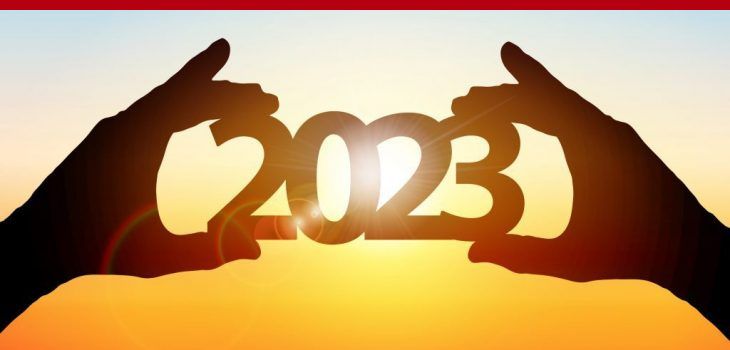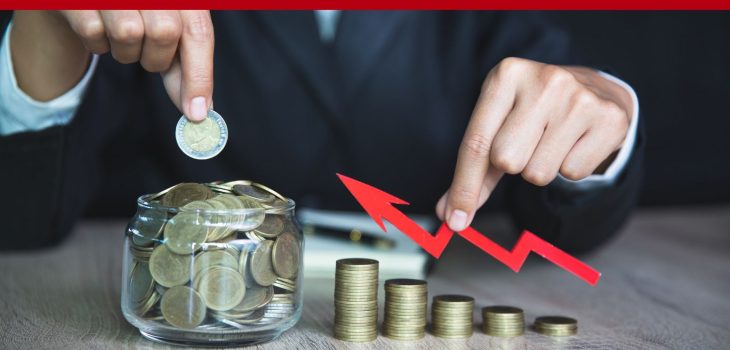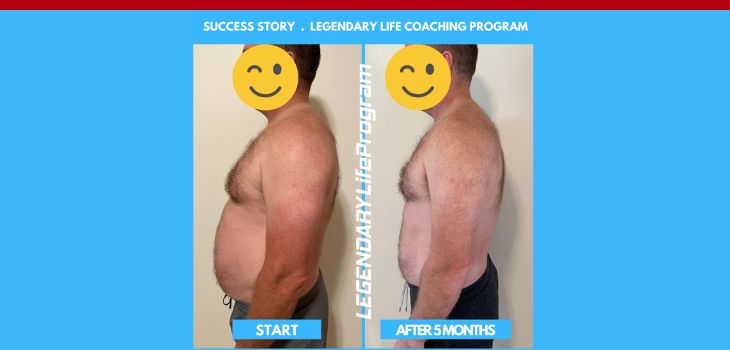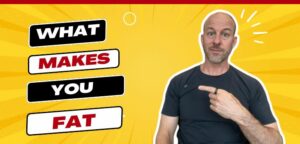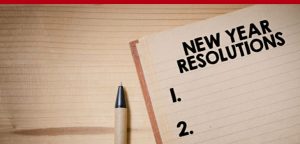In this new 5-part series called “Make 2023 Your Best Year Ever”, Ted will address the biggest diet problems that stop you from losing weight, reclaiming your health, and creating the body you deserve in 2023.
In part 1, Ted explains why after years of trying and failing, most people believe it is not possible to get in shape (and what to do about it).
>>>Click here to listen to part 1
In part 2, Ted talks about the underlying reasons why we overeat, why most coaches don’t talk about it, and how to conquer emotional eating.
>>>Click here to listen to part 2
In part 3, Ted explains why most people can’t lose weight no matter what (and what to do to finally get the body you deserve.)
>>>Click here to listen to part 3
In part 4 Ted talks about why strict diets & extreme workouts don’t work long-term (and what works for high achievers over 40)
>>>Click here to listen to part 4
In part 5 Ted talks about why it is so hard to find who to believe among millions of fat loss experts on the internet; he shares what he learned from his mentors and their mistakes and how he evolved his approach to fat loss. Also, he puts all the pieces together and reveals a 5-step process where you can see results in less than 30 days.
This series is based on 22 years of experience, including real-life strategies developed, tested, and refined while working with hundreds of high achievers who want to lose fat and transform their bodies while growing their businesses or careers. Tune in so you can make 2023 your best year ever!
You’ll learn:
- About Ted’s mentors, their teachings, and the things they were doing wrong
- The most important thing you have to do to lose fat
- What can you achieve in 30 days of implementing the Fat Loss 101 approach
- The real reason why your food choices matter
- How much weight you need to lift when lifting weights
- What is the right amount of protein you should eat per day
- The Life-Changing Power of a Daily Walking Habit
- And much more…
Related Episodes:
484: How To Make 2022 Your Best Year Ever with Ted Ryce Part 1
485: How To Make 2022 Your Best Year Ever with Ted Ryce Part 2
486: How To Make 2022 Your Best Year Ever with Ted Ryce Part 3
Links Mentioned
Schedule Your 15-Min Strategy Call NOW and Unlock Your SPECIAL HOLIDAY bonus
Watch My FREE Body Breakthrough Masterclass
Want To Lose Fat, Transform Your Body & Live Your Best Life In 2023?
The 2023 enrollment for the Legendary Life Coaching Program is OPEN!
If you sign up in the next five days, you’ll get a special bonus: 2 Extra Weeks for FREE, so you can get started right away and already have results before Christmas.
All you have to do is schedule a 15-min strategy call and you’ll lock in your SPECIAL HOLIDAY bonus.
Go to legendarylifepodcast.com/apply and schedule your 15-min strategy call with me.
Hurry up because we only have 8 spots available for group coaching and 3 spots available for private coaching!
Let’s make 2023 the year you’ve created the body you always wanted.
Podcast Transcription: Make 2023 Your Best Year Ever: Part 5: The 5-Step Process To Burn Fat & Transform Your Body In Less Than 30 Days
Ted Ryce: One of the biggest challenges that my clients have when they first joined my coaching program is they come from a place of, “I didn’t know who to believe, Ted. People say so many things, one expert says one thing, another expert says another. Some of them are even doctors, some of them have PhDs, some of them are totally shredded, and I don’t know who to believe. Who’s right, who’s wrong? I don’t know, it’s very frustrating.”
And when they share that with me, I resonate at a deep level because I went through a long journey, I always talk about how I’ve been in this business for over 20 years. And one of the. Parts of my 23-year journey was going through a process of figuring out who to listen to. So, if you are in a position right now where you are not sure who to believe when it comes to fat loss, changing your body, health, well, we’re going to dive into that today.
So, what is up, my friend? Welcome back to the Legendary Life Podcast, I’m your host, Ted Ryce, health coach for, like I said, over two decades now. And we are doing a Best Year Ever series, or “Make 2023 Your Best Year Ever,” and this is going to be the fifth installment. And what we do here at Legendary Life is, we work with founders, entrepreneurs, busy professionals to help them lose fat, boost energy, and make it into a lifestyle so they never have to go on another diet again, so, they never have to ask what is it that I should do now to take care of my health, because I’m still not sure.
And the very transparent reason for this podcast is because I want to help you, I want to help you avoid the mistakes that I made, I want to help you avoid going down the rabbit holes of misinformation that I went to, went down into. And the second reason, again, very transparently, is some of you are going to want my help to make a transformation, to achieve a level of health and fitness, and comfort in your body, confidence in your body that you’re probably not going to be able to achieve in a reasonable timeframe on your own.
And when you’re looking around for who to hire, I want that to be me, those are my reasons for this show. To help and to get hired. So, with that said, let’s get into the episode today. And I want to tell you, I’ve been in this business since 1999, and it has been quite a journey of figuring out who to believe, and who to not listen to. And I fell into, I don’t want to call them cults, but it almost felt like a cult, some of the personalities in the fitness industry, you may not know them. Like Paul Check, Charles Poliquin, those are the people I learned from, Charles Poliquin actually did a show, he passed away now, but he did a show with Tim Ferris.
Paul Check, I don’t know if he’s done one or not, but those were my gurus, you could say, when I first started when I was 22 years old. And I learned a lot from them, and I also learned that they were wrong about a lot of things, although they were very confident at the time, and I was very confident, But I got to a place in my mid-30s, like I’ve mentioned in this series, and many times in the podcast, I was at a place where I was 35, maybe 36. I went from 185 pounds to 210 pounds, my blood sugar levels were pre-diabetic, my cholesterol was a mess, and I felt terrible.
And back in the day when I first started, before paleo was even a thing, before Loren Cordain, came out with his paleo book, before Rob Wolf. I was part of that ancestral eating. Paul Check got me into that. And low carb was hot at the time, so I came in, so, when I got fat, I had two beliefs with me.
Number one was that carbs, when you ate them, they raised your blood sugar levels, which is true by the way, which raises insulin levels, which is also true by the way. And insulin is a fat storing hormone, therefore, carbs make you fat. That was the one principle, which we’ll get into that in a minute here.
The other principle was that the quality of your food mattered a lot for fat loss, meaning the chemicals in the food, the xenoestrogens and the pesticides in your food, the xenoestrogens in your shampoo and toiletries, those are the things that could cause you to get fat, regardless of how much you were eating, and all those other factors that we’re going to be talking about here.
So, I was really confused when I got fat, even though I was living a super clean lifestyle and buying all my shampoo and toilet cleaners and dish soaps at Whole Foods, and toxin-free laundry detergent. It didn’t make a difference, I still got fat and was unhealthy, I was really pissed off, what’s going on here?
And I eventually, like I shared in this series, I was able to figure it out. And so, what I’m going to share with you today is what I would call the fat loss one-on-one five step process. If you just do the five steps that I’m going to teach you today, you will be able to achieve results, I don’t care what your hormone status is, I don’t care how many carbs you’re eating,
I don’t care if there’s xenoestrogens in the shampoo you use, you’re going to lose fat. And it took me a while to get here. And now I’m at a place where I’m supremely confident about my strategies.
And again, I wasn’t always that way, I was really, when I first started, it was about 50% of the people got results with me, and 50% really struggled, and I was always frustrated. I thought there was something wrong with them, or I always blamed it on them. But eventually when I got into poor health, and I was doing “all the right things,” I needed to reexamine. So, these five things, these five steps is how I can summarize how to get results no matter what your situation is.
And the first thing that I learned is that you need to be in a calorie deficit, you need to be in a calorie deficit to lose fat. Not keto, not low carb, not paleo, not low fat, not intermittent fasting, not giving up bread forever, not never eating a piece of birthday cake with your daughter, or sharing a dessert on date night. You need to be in a calorie deficit, and you can do that eating paleo or not eating paleo.
You can do that eating bread or not eating bread, those choices aren’t as important as you think. In fact, I squeeze in dessert regularly these days. Now, I’ll be honest with you, I’ve been under a bit of stress, I’m managing it well, going to the spa, meditating, I’m meditating today. But still I’ve got some things going on, and I had a carrot cake today from this place—It’s not a huge piece of carrot cake like you would get in the United States, thankfully.
But I’m squeezing in dessert regularly, and I’m still getting leaner though, and it’s because I create a calorie deficit. And I want to say one more thing before we go on here, a couple things, number one, I’m not asking you if this is correct or not, I’m telling you with Supreme 100% confidence, this is what I know works.
I know that’s a strong statement to make, but folks, I’ve been doing this for 23 years, I don’t even really focus too much on nutrition and the strategies and the things that I teach here, most of what I do is on the psychological side these days. Because this is so simple for me. Again, I’m not trying to condescend or anything like that, just trying to tell you where I am.
The second thing I want to say is I’m not expecting you to believe me though. I’m not saying you need to believe me, or you must believe me, or you’re stupid for not believing me, I know how hard it is out there to figure out who’s telling the truth or not. But I do want to say this, I challenge you to follow what I’m going to tell you here and see if you don’t get results.
So again, back to the calorie deficit, what’s the best way to get into a calorie deficit without getting on a strict diet? Track your food. You’ll learn more about fat loss from tracking your food for 30 days than you will reading 30 diet books.
I want to repeat that again, you will learn more about fat loss nutrition from tracking your food for 30 days, than you will from reading 30 Diet books. Track your nutrition. Hell, track it for a week, because again, people start saying, “I don’t eat that much,” then they track their calories and say, “how am I eating this much?” That’s what happens every single time.
Number two, your food choices do matter, but not for the reasons you think, it’s not about carbs, it’s not about any of those things, it is about managing your hunger. This is where food choices come into play. Now, we’re going to set aside the micro nutrition, in other words, the vitamins, the minerals, the phytonutrients, we’re going to push that to the side.
Those are important, but we’re talking about fat loss here, because fat loss is the foundation. Optimizing your diet because you read that blueberries increased B-D-N-F, as opposed to pineapple, that’s an optimization strategy that you need to layer on top of a strong foundation, and that foundation is fat loss. And also, food choices to manage hunger.
Because if you’ve got a belly, and you’re worrying about how much spirulina you need to eat, your focus is in the wrong place. So this is again, where the food choices come into play, and it’s about managing hunger. And where you want to go to learn more specifically about this besides my podcast is Google “the satiety index.”
Right now, pause this podcast, go to the satiety index and look at it for a bit, take a look at, study it, study the satiety index, start to…And again, I’m not asking you to accept it or accept what I’m saying as gospel. What I’m asking you to do is to study it and test it, test it.
And if you’re looking at it right now, which if you aren’t, you can bring it up and look at it, of course, if you’re driving, do this later. Look at red meat and white fish at the top, look at how—or I should first say this, on the bottom, we have a 100, 200, 300, and so, what we’re looking at is the longer that blue graph, the more full you’re going to feel after eating this food. And on the Y axis, we have the food.
So, X axis is how satiating a food is, and the Y-axis is the types of foods. So, we have white fish and red meat, very satiating. Check out potatoes, how many times have people told you, oh, stay away from potatoes, but look, boiled potatoes, and it’s really important that you realize that this is boiled potatoes score off the charts, it outperforms every other food that was tested, not all foods are tested, obviously, but all the foods that were tested in this study.
That was done in 1995 in the University of Sydney, Australia. See that porridge, AKA oatmeal scores quite high too, oranges score higher than bananas and brown rice. And I want you to take a look at potatoes again, and then I want you to look at the section marked hyper palatable foods.
So, there’s a few different satiety indexes, I have one that I like a lot because it’s color coded and it breaks down the foods into proteins, fats, carbohydrates, refined carbohydrates, and hyper palatable foods. But let’s look at the potato chips, what happens when we take a potato and instead of boiling it, we slice it into chip sized pieces, and we fry them in oil?
Number one, what does frying a potato in oil do to its calorie content? Do you know? It increases it. Why? Because it’s fried in fat, and the fat stays on the potato chip, that’s why your hands get all greasy, or the napkin gets all greasy when you have a bunch of potato chips on it. And when you eat the potato chips, that grease goes into your gut and gets digest.
So, it adds fat, so it higher in calories. So, if you ate a potato, boiled potato one day, and then the next day you took the exact same potato, a sized potato, slice it into potato chip sized pieces, fried it until it was super crispy and then ate it, it’s higher in calories, but it’s also less satiating.
Do you see how that could be a problem? Because people say I don’t eat that much, and what they’re really saying when I hear it is, I only eat when I’m hungry, or I only eat until I’m satisfied. I just had a bag of potato chips, and the bag of potato chips is like three, two, or three or even four hundred calories, depending on the size. Except it doesn’t do anything for your hunger.
You can eat a bag of potato chips and still be quite hungry. Thankfully, I don’t like potato chips that much.
And check out French fries, if you take the potato and cut it into fry sized pieces, and then fry it in oil, it’s also higher calories, but it’s a little bit more satiating. What’s the difference? Why are French fries more satiating than potato chips? Any idea?
If you answered, the water content, because potato chips, there ain’t no water in potato chips, they’re super dry if you answered the water content, because when a fry is cooked properly, it’s crispy on the outside, but kind of mushy on the inside, and that mushiness means that there’s moisture in there, has more water in it, and that water content’s really important.
So again, that’s just a few big takeaways from this tidy index. What I want you to do is experiment with the satiety index, see how many foods you can choose off of this to see how it affects your hunger when you eat the foods.
Now, the next thing that I want to talk about is lifting weights. A lot of people are confused about what the best form of exercise is to lose body fat. In fact, I have a client recently who’s been, who’s lost 50 pounds with me, and on our group coaching call the other day, he was like, “You told me that…” he’s taking a break from playing tennis, and Dan, if you’re listening, this is no slide against you, it’s just an example of how sometimes I realize I need to get better at communicating.
So, he was saying, he’s taking a break from tennis, and he was saying, ‘Ted, I didn’t realize that doing more weights would give me better results. I just thought I was going to replace the tennis with cardio.” And I said, “There’s no problem with replacing tennis with cardio, but if you want the best results, do more sets,” because we had him working out four times a week for 20 minutes, and that’s fine, he’s lost 50 pounds. But to get to that next level, man, bump it up to 30 minutes, add some sets, add some exercises.
And what’s interesting is, weights—and I want you to pay attention here, because this is where a lot of people, again, the psychological stress can cause them to quit. I’ve been, this person didn’t end up working with me, but she said, “Every time I lift weights, I gain weight, and I hate it. So, you’re not going to tell me to lift weights, are you?”
I was like, this is probably not going to be a good client for me, because I don’t care about your weight, I care about fat loss, and how sexy you look, and how sexy you feel in your bathing suit, right? That’s what I care about.
And so, what I’m trying to tell you here is, when you lift weights, your weight might go up, that is fine, because you’re gaining muscle, especially if you’re a couch potato or you’re just a few years behind on your workouts, but you used to be in shape, you’re going to gain muscle fast.
It’s so funny, people who are out of shape don’t realize that they’re in the prime position to grow muscle super-fast. So, if you’ve never gained, if you’ve never worked out before, or you’re, again, a few years behind on your workouts, you’re going to gain muscle fast. Muscle, does it weigh something? Yes, it does.
So, you’re going to gain weight. Some of my clients—no, actually none of my clients gain weight. Sometimes initially, but they lose weight very quick, because I have a rapid jumpstart, a rapid fat loss plan that I put them on initially, so that typically doesn’t happen or doesn’t happen, and maybe their weight jumps up for a day or something.
But if you’re not doing something like that, your weight may jump up, you are doing the right thing. You have to not listen to your automatic thoughts that we talked about in the first episode and say, this is the right thing, lifting weights is the right thing. Yes, I’m up a pound or two because I’m lifting weights, but it’s the right thing to do, I need to keep doing this.
And when I say lifting weights, I don’t mean barbells and dumbbells, it can be body weight, kettlebells, gymnastics rings. It could be exercise bands. What I’m talking about is some form of resistance training taken too close to failure, doesn’t matter what exercises, could be machines, could be free weights, could be cables, doesn’t matter as much as you think, especially if you’re at the beginning.
Now, if you’re ripped, and you want to optimize your physique and build bigger biceps, that’s another conversation. But if we’re talking about getting rid of your belly, this is what you want to focus on. The tool doesn’t matter as much as you think.
The fourth thing is prioritize protein. Again, this is another example of two things, number one, a lot of people think they’re eating quite a bit of, or quite a few grams of protein, but they don’t eat as much as they think, because they don’t track it. So, if you think an egg or a ribeye steak is a good source of protein, then I want to go back to what I said initially, track your calories for 30 days, track your macros, you are not eating as much protein as you think.
Well, how much protein should I eat, Ted? Well, we’re talking about 0.8 grams per pound of body weight, that’s what we’re talking about. Even if you’re obese, that’s a good place to start. So, that means if you weigh 200 pounds, we’re talking 160 grams of protein per day. Whoa, Ted, that’s a lot.
Well, it’s a lot because you haven’t been doing it, and once you eat that much protein, you won’t be as hungry, and you’ll gain more muscle and lose fat faster, as long as you’re lifting weights. This is, I’m telling you folks, this is the key, I’m giving you the keys right here, all you need to do is take action on it, all you need to do is take action on it, your body will change rapidly. Give it a month, you’re going to be like, oh my gosh, why didn’t I do this sooner? That’s what you’re going to say.
And I want to give you one more, daily steps. I want to say this, if you’re down in your calories, especially if you’re overweight or obese, you should be able to lose fat while lying in bed, you don’t have to lift weights, none of that. But the reality is, we’re not talking about—we’re talking about making this easy, and we’re talking about making it into a lifestyle.
So, while you may lose fat for a week of lying in bed, the reality is eventually you’ll have to increase your daily movement to manage your hunger, and it also means that you’ll be able to eat more and stay lean, when you’re having more, when you’re walking more.
And this is one of those habits. Americans just don’t walk very much, and I don’t want to get into the longevity benefits of walking, but I will tell you, there are longevity benefits of walking, or and when I say walking, I don’t even mean all at once, going for a 10,000k step walk, I’m talking about getting in the steps throughout the day.
If you just do that, good things are going to happen to you, it’s going to make this so much easier, and all you got to do is track your steps. For me, I get 10,000 steps a day, 10 to 11, I’ve been doing that for the past three years, how do I know that?
Well, the aura ring tells, even if it’s not perfectly exact with the step count, I’m in the ballpark somewhere, and so I’ve been getting 10,000 steps a day for the past three years.
Again, average, some days the steps are quite low, but average, 10,000 steps a day. Do you have to do that though? How many steps should you do? And what I would tell you is, check your cell phone right now. Your cell phone, I use an iPhone, I don’t know about other phones, but I’m sure they’re tracking your steps too.
Look in your Apple Health if you’re an iPhone user, and you’re going to see, you’ll get a step average if you look in that health app, look at your step average, bump it up 2,000 steps for a week.
Actually, let’s do this, let’s make this into a monthly challenge, track your food for 30 days, study the satiety index every day for 30 days. Lift weights two to three times a week for 30 days. Prioritize your protein by tracking your food and making sure you’re hitting close to that point eight grams per pound of body weight target for 30 days. And then look at your daily steps and bump them up by 2,000 for 30 days.
I mean again, this isn’t what I would give a client necessarily without talking to them more, but it’s something I can tell you to do. And even if you do 85% of what I tell you right now, even if you miss 85%, you’re still going to get better results than anything else you’ve ever tried. Again, I’m not asking you to believe me, I’m asking you to believe me enough to give it a try.
So, in closing, what do you need to do? Well, I gave you the answers, for 30 days, track your nutrition, look at the satiety index for 30 days when it comes to planning your meals, lift weights 2 to 3 times a week for 30 days, prioritize your protein to make sure that you’re getting that 0.8 grams per pound of body weight for 30 days and get 2,000 steps more than what you’re getting right now for 30 days.
Your body will change, regardless of your age, regardless of your hormones, the low T, the menopause, the toxins in the environment, how many carbs you eat, none of that stuff matters. If what I just told you is dialed in, you’re going to get results, again, not asking you to believe me, just trust me enough to give it a try. And you don’t even have to be a hundred percent.
That is it for this episode, folks. I hope you enjoyed “Make 2023 Your Best Year Ever.” I hope 2023 is your best year ever, and I want to say that you can, by taking action, you can make it your best year ever, and also tell you, one of the biggest achievements you can ever do in life is to get yourself into good shape and maintain it.
There are so many benefits, so many benefits to your relationships, to your work, to your mental health, to your enjoyment of life, but you’ve got to take action. That is it for me, I hope you enjoyed this series, I really care about you a lot. I may not know you, we may not know each other, we may never even meet or talk on social media, but I care about you, and I want you to know that you can get this, you can achieve this, you can make this happen for yourself. All you have to do is take action.
Sign up to receive email updates
Enter your name and email address below and I'll send you periodic updates about the podcast.



